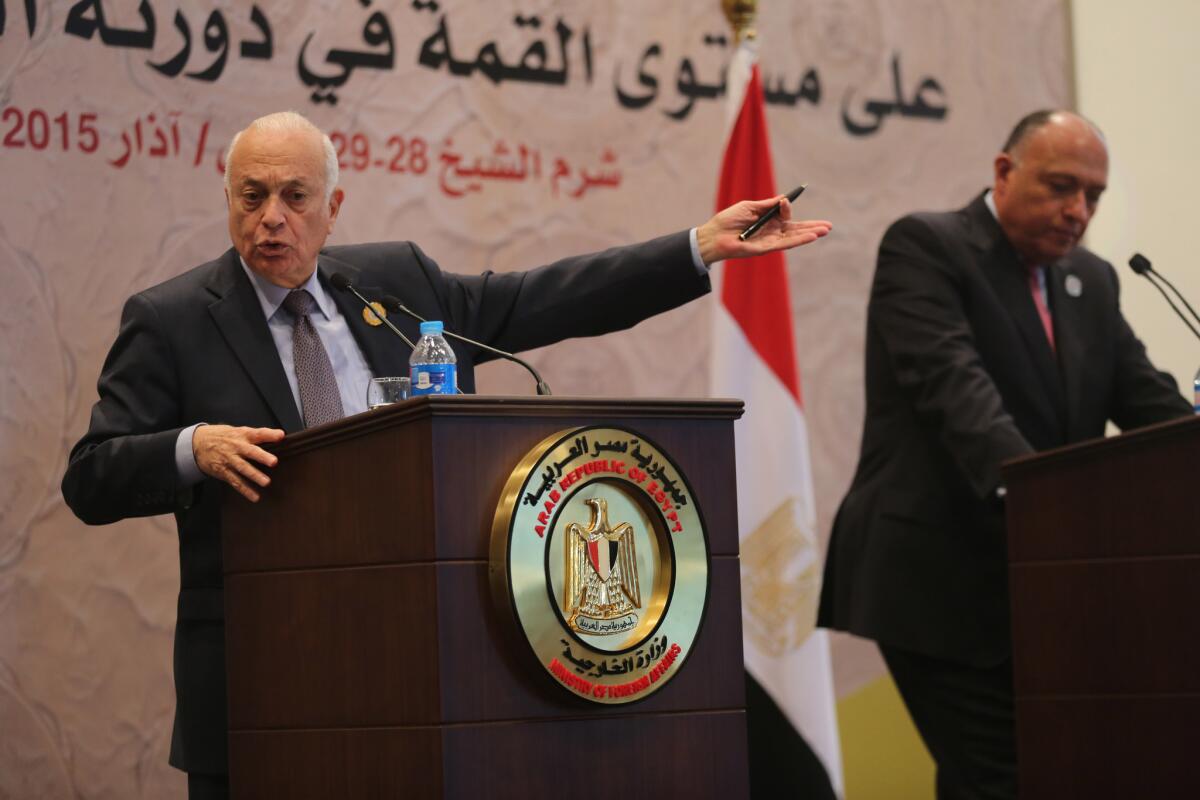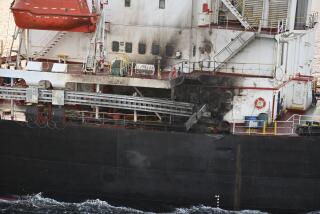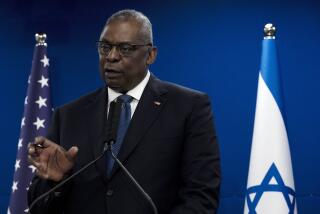Arab League’s joint military force is a ‘defining moment’ for region

Arab League Secretary-General Nabil Elaraby, left, and Egyptian Foreign Minister Sameh Shukri hold a news conference at the conclusion of the Arab summit in Sharm el Sheik on March 29.
- Share via
reporting from Cairo — Alarmed by the potential for civil war in Yemen, Arab leaders agreed Sunday to the creation of a joint military force that would attempt to bring some stability to the region and serve as a counterweight to the influence of Iran.
The heads of the Arab League countries said the unit would be made up of volunteers and could be called up if a member state were facing a security or safety threat.
Fahad Nazer, a political analyst in Washington who specializes in Saudi Arabia, said the creation of the force is “a defining moment for the Saudis, and it might be a defining moment for the region in general.”
The agreement was made on the second day of the Arab summit in the Egyptian Red Sea resort of Sharm el Sheik, where the crisis in Yemen was high on the agenda.
Saudi-led airstrikes targeted key military sites and weapons depots for a fourth day Sunday in an effort to drive out Shiite Muslim Houthi rebels who are advancing through the country.
The Arab League’s statement, read by Secretary-General Nabil Elaraby, said that the coalition operation would “continue until Houthi militias withdraw and submit their weapons.”
He added that the challenges faced by Arab nations are “obvious and unquestionable” and that intervention in Yemen became necessary after all peaceful avenues were exhausted.
The creation of the unified force, announced by Egyptian President Abdel Fattah Sisi, has long been an ambition of the 22-member Arab League, but one that had proved unattainable.
“The Arab leaders have decided to agree to the principle of a joint Arab military force,” Sisi said.
A “high-level” team would be created to look at the structure of the force, he said.
Citing Egyptian military and security officials, the Associated Press reported that the proposed force would comprise 40,000 elite troops and have its headquarters in the Egyptian capital, Cairo, or Saudi capital, Riyadh.
Elaraby said that joining would be optional for Arab League members and that Iraq has already voiced its concerns about the idea, according to Saudi-owned Al Arabiya television.
Nazer, who works for JTG Inc., an intelligence and analysis company based in Vienna, Va., said the force’s creation reflected a “paradigm shift” for the Saudis, who haven’t typically taken such an assertive role.
“It’s about the need for the Arab region as a whole to be more assertive and take control of their future and not keep forever dependent on the West and the U.S. to secure their security,” he said.
“The Saudis have never had this kind of hands-on military approach that they’ve already demonstrated over the past few days,” said Nazer, who formerly worked for the Saudi Embassy in Washington.
“We haven’t had this kind of unified front in the Arab region for quite a while,” probably not since the 1991 Persian Gulf War, he said. “It’s a fairly broad coalition with a lot of countries with different policies and different interests. They have come together and committed their own troops.... These are big commitments.”
As airstrikes continued, Ahmed Hassan Asiri, a spokesman for the Saudi-led mission, said in his Sunday briefing that the militias had been driven out of contested air bases and all jet fighters in the country had been destroyed.
Scud missiles also have been targeted in the last 24 hours and many have been eliminated, he said.
But Asiri warned that there remains a chance the Houthis are still hiding some missiles. Saudi-led forces were working hard to locate them, he said.
Despite the heavy bombardment, Houthis continued to advance toward Saudi Arabia’s southern borders and Yemen’s southern coastal city of Aden.
Asiri said the militias were deliberately targeting residential areas to confuse people into thinking that their homes were being attacked by the coalition carrying out airstrikes.
Medical sources in Hudaydah said the airstrikes that targeted the airport there had damaged some nearby houses and injured 30 people, mostly women and children. Some were in critical condition.
Saudi tanks were also seen mobilizing toward the Yemeni border, heightening fear that a ground invasion could be imminent.
The strikes are supported by embattled President Abdu Rabu Mansour Hadi, who was forced to flee Aden several days ago.
He says the militias are backed by Iran, a claim the Islamic Republic denies, and he told the Arab summit Saturday that the strikes must continue until the rebels are defeated.
That call was backed by Saudi Arabia’s King Salman, who said the operation will continue “until it achieves its goals for the Yemen people to achieve security.”
Special correspondent Boyle reported from Cairo and Al-Alayaa from Sana, Yemen. Special correspondent Amro Hassan in Berlin contributed to this report.
More to Read
Sign up for Essential California
The most important California stories and recommendations in your inbox every morning.
You may occasionally receive promotional content from the Los Angeles Times.













